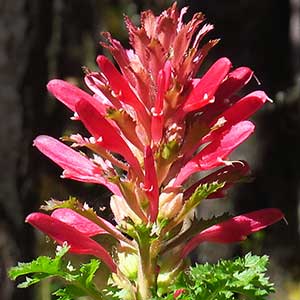Pedicularis densiflora
Pedicularis racemosa
Indian warrior, warrior's plume
leafy lousewort, parrot's-beak, sickletop lousewort, white sickletop lousewort
basal 1–10, blade lanceolate, 30–200 x 20–70 mm, 2(or 3)-pinnatifid, margins of adjacent lobes nonoverlapping or extensively overlapping distally, 1-serrate, surfaces glabrous, hispid, or downy;
cauline 4–20, blade lanceolate, 15–250 x 5–100 mm, 2-pinnatifid, margins of adjacent lobes nonoverlapping or extensively overlapping distally, serrate, surfaces glabrous, hispid, or downy.
basal 0;
cauline 8–25, blade linear or narrowly lanceolate, 10–80 x 3–15 mm, undivided, adjacent margins nonoverlapping, 1- or 2-serrate, surfaces glabrous.
simple, 1–5, exceeding basal leaves, each 10–50-flowered;
bracts lanceolate to trullate, 10–35 x 3–5 mm, undivided or 1-pinnatifid, proximal margins entire, distal 1- or 2-serrate, surfaces glabrous.
simple, 1–4, each 3–25-flowered;
bracts lanceolate, 5–40 x 3–10 mm, undivided, proximal margins entire, distal 1- or 2-serrate, surfaces glabrous.
2–4 mm.
1–3.5 mm.
calyx 9–18 mm, downy to tomentose, lobes 5, triangular, 3–4 mm, apex entire, ciliate;
corolla 23–43 mm, tube dark red, purple, or orange-yellow, rarely white, 8–18 mm;
galea dark red, purple, or orange-yellow, rarely white, 15–25 mm, beakless, margins entire medially and distally, apex straight;
abaxial lip dark red, purple, or orange-yellow, rarely white, 8–15 mm.
calyx 4.5–7 mm, glabrous, lobes 2, triangular to deltate, 0.5–1 mm, apex entire, glabrous;
corolla 10–15 mm, tube white or light pink, 6–9 mm;
galea white or light pink, 4–6 mm, beaked, beak sickle-shaped, 5–8 mm, margins entire medially and distally, apex not extending beyond abaxial lip;
abaxial lip white or light pink, 4–5 mm.
= 16.
= 16.
Pedicularis densiflora
Pedicularis racemosa
Scarlet corollas with an undomed, toothless galea and two- or three-pinnatifid leaves are diagnostic of Pedicularis densiflora. This species occurs in forested subalpine regions of southern Oregon, western slopes of the Sierra Nevada, and the Coast Ranges of California south to Baja California. Herbarium records indicate northern populations of P. densiflora occur at higher elevations than do more southern populations.
(Discussion copyrighted by Flora of North America; reprinted with permission.)
Subspecies 2 (2 in the flora).
Pedicularis racemosa occurs in the Rocky Mountains from southern Canada to New Mexico, in the Cascade Range from British Columbia to California, and in mountainous areas of Arizona.
Herbarium sheets of Pedicularis racemosa are sometimes misidentified as P. contorta or P. groenlandica, but the calyx has two lobes, not five as in the latter species. The uncoiled beak also bends downward from an undomed galea, which the large lateral lobes of the abaxial lip often conceal, whereas the coiled beaks of P. contorta and P. groenlandica are very noticeable.
(Discussion copyrighted by Flora of North America; reprinted with permission.)
1. Corolla tubes light pink; cauline leaf blades narrowly elliptic-lanceolate, widest at middles. | subsp. racemosa |
1. Corolla tubes white; cauline leaf blades linear to linear-lanceolate, widest near bases or at middles. | subsp. alba |


